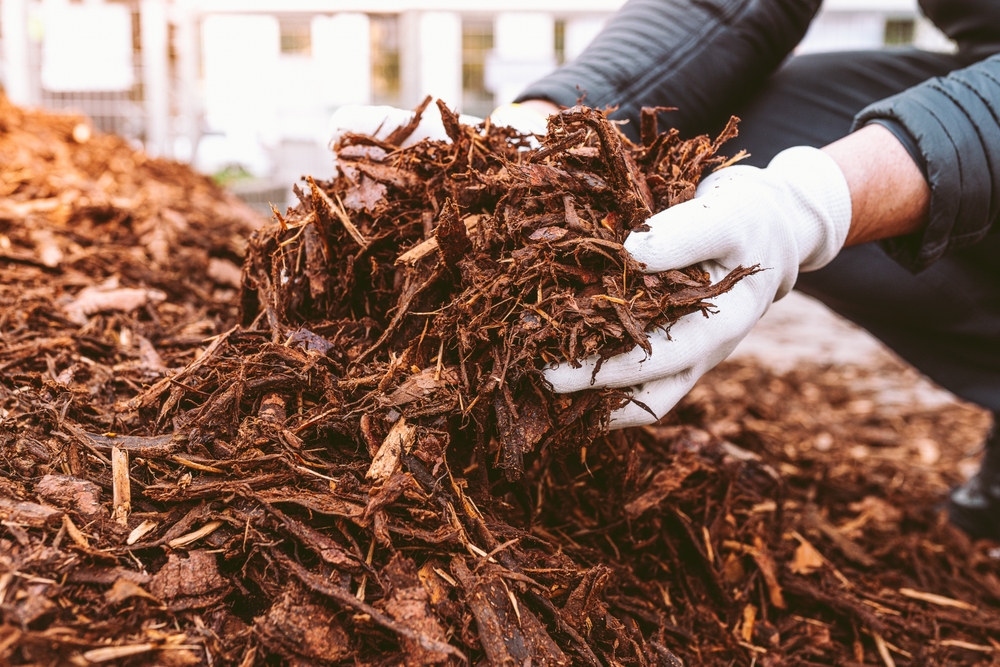
As the summer heat intensifies, it can take a toll on the health of trees in your yard. While trees are resilient, they need extra care during the hotter months to thrive. One of the most effective and simple ways to protect trees from the harsh summer heat is by mulching around them. Mulch acts as a protective layer that benefits trees in numerous ways, from temperature regulation to moisture retention. In this article, we’ll explore the importance of mulching around trees in the summer heat, the benefits it provides, and how to properly apply mulch for optimal tree health.
Mulching Helps Retain Moisture
One of the biggest challenges trees face during the summer months is a lack of water. As temperatures rise and rainfall becomes less frequent, the soil around trees can dry out quickly. This can lead to dehydration, causing stress on the tree and making it harder for it to survive the heat. Mulching plays a crucial role in moisture retention. A thick layer of mulch helps slow down the evaporation of water from the soil, ensuring that your tree’s roots have access to the moisture they need, even during dry spells.
When you apply mulch around a tree, it forms a barrier that helps keep the soil cooler and more hydrated. This is especially important for young or newly planted trees, which are more vulnerable to water loss. For established trees, mulching can still help conserve water, especially if you live in an area where summer heat can cause the soil to dry out quickly. By keeping the soil moist, you reduce the risk of water stress, which can lead to yellowing leaves, wilting, and in some cases, tree mortality.
Mulch Prevents Soil Erosion
Soil erosion is another concern that can be exacerbated by summer heat. During hot weather, heavy rainfall can wash away loose, dry soil, especially around tree roots. This erosion not only damages the soil structure but can also expose the roots to the elements, which can harm the tree. Mulching around trees acts as a protective barrier against soil erosion. The mulch helps hold the soil in place, preventing it from being washed away by rain or disturbed by strong winds. By maintaining a stable soil structure, mulch ensures that the tree’s roots remain protected and secure, reducing the risk of root exposure or damage.
In areas with slopes or high winds, erosion can be particularly problematic. Mulch provides an added layer of stability to the soil, keeping it intact even in challenging conditions. This can be especially beneficial for trees in locations where heavy storms are common during the summer months. By preventing erosion, you can help ensure that the tree has the solid foundation it needs to grow strong and healthy.
Mulch Regulates Soil Temperature
Just as mulch helps retain moisture, it also plays a vital role in regulating soil temperature. During the heat of summer, the soil around trees can become excessively hot, which can negatively affect root health. Tree roots are sensitive to temperature fluctuations, and when the soil becomes too hot, it can stress the tree, making it harder for it to absorb nutrients and water. A thick layer of mulch acts as an insulating layer that helps keep the soil temperature more consistent. It protects the soil from the scorching sun, preventing it from overheating and ensuring that the roots remain cool and healthy.
This temperature regulation is especially beneficial during periods of extreme heat, when soil temperatures can spike to dangerous levels. Without mulch, the soil can become so hot that it actually begins to burn the roots, leading to irreparable damage. By providing shade and insulation, mulch keeps the soil at a more stable and moderate temperature, giving the tree’s roots a better environment in which to grow.
Mulch Reduces Weed Growth
Weeds are not just unsightly; they can also compete with trees for essential resources like water and nutrients. During the summer, weeds tend to thrive, making it harder for your tree to get the sustenance it needs to survive the heat. Mulching around trees helps prevent weed growth by blocking sunlight from reaching weed seeds in the soil. This reduces the chance of weeds sprouting around your tree, giving the tree more space to absorb water and nutrients.
Weeds can also interfere with proper air circulation around tree roots. By smothering weeds with mulch, you create an environment that promotes healthy root development. This can help your tree grow stronger and more resilient, especially during the hot summer months when competition for resources is at its peak. For added benefits, using organic mulch, such as wood chips or bark, can decompose over time and further enrich the soil with nutrients, benefiting the tree in the long run.
Proper Mulching Practices for Maximum Benefits
While mulching is beneficial, it’s essential to apply it correctly to reap the full benefits. Improper mulching can lead to a range of problems, from waterlogging to rot. The first step in proper mulching is selecting the right type of mulch. Organic mulches, such as wood chips, bark, or shredded leaves, are ideal because they provide moisture retention, temperature regulation, and soil enrichment as they decompose. Avoid using inorganic materials like gravel or plastic, as they do not offer the same benefits for the soil or tree.
When applying mulch, aim for a layer that’s about 2 to 4 inches thick. Too little mulch will not be effective, while too much mulch can cause problems such as poor air circulation and waterlogged soil. It’s also crucial to keep the mulch away from the trunk of the tree. Mulch piled directly against the trunk can trap moisture and promote rot. Instead, spread the mulch in a circular pattern around the base of the tree, extending it out to the edge of the tree’s canopy, or the drip line. This ensures that the entire root zone benefits from the mulch without causing harm to the trunk.
It’s important to refresh the mulch regularly to maintain its effectiveness. Over time, mulch breaks down and decomposes, so you may need to add new layers each year, especially in areas where rainfall is frequent. Additionally, if you notice any signs of mold, fungus, or pests in the mulch, be sure to remove the affected material and replace it with fresh mulch.
Conclusion
Mulching around trees during the summer heat is an essential practice that provides numerous benefits to the health and longevity of your trees. By retaining moisture, preventing soil erosion, regulating temperature, and reducing weed growth, mulch creates a healthier environment for trees to thrive in the harsh summer months. Proper mulching practices can make a significant difference in the success of your trees, helping them grow strong, vibrant, and resilient. If you’re unsure about the best mulching techniques or need assistance with tree care, consider consulting tree services professionals who can help guide you in maintaining the health of your trees throughout the seasons.
Need Tree Services In Loveland, CO?
Established in 1996, our team here at Rocky Mountain Tree Service is a tree service based in Loveland, Colorado. We specialize in a variety of services including tree trimming, tree removal, shrub & hedge trimming and removal, stump grinding, yard work, storm damage clean-up, and more. As an ISA Certified Arborist with over 20 years of experience, we value providing quality services at an affordable price. We are Open Monday-Friday with weekends being open by appointment or emergency only. Contact us today for more information!

